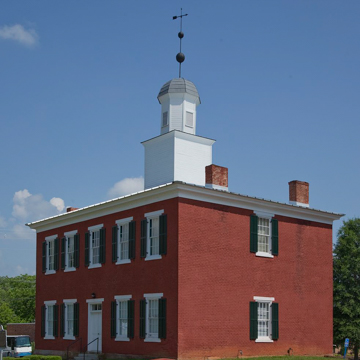Alabama’s oldest surviving courthouse is an architectural composition repeated in scores of public and institutional buildings across early America. The hipped roof block of the Old Morgan County Courthouse is topped by a domed belfry whose bell summoned the community in times of celebration or crisis. The same courthouse format—with a gilded eagle added to the belfry—was seen as early as 1814 in neighboring Madison County, across the Tennessee River to the north. It was a form especially popular in the Ohio Valley and as far south as Middle Tennessee, spilling over into those North Alabama counties that tended to take their architectural cues from the states further north.
Morgan County was established by the Alabama territorial legislature in February 1818, ten months before the state formally entered the union. A few months later, the village of Somerville, located in the north-central part of the county five miles south of the Tennessee River, was designated the seat of justice. Due to the vagaries of local politics and a shifting pattern of settlement, the construction of a substantial brick courthouse, one commensurate with those that already existed in the wealthier cotton-producing counties to the west and north, was delayed until the late 1830s. Neither builder nor architect is documented, but it could have been Hiram Higgins of Athens in adjacent Limestone County. Born in 1806 in Mount Sterling, Kentucky, Higgins is credited with at least three other Alabama courthouses built between 1830 and 1860 and now destroyed.
As was customary, county offices occupied the first floor of the Somerville courthouse, the second being given over to a large courtroom and a pair of ancillary chambers. The building’s eight fireplaces (two in the courtroom itself) were framed by simple, Federal-style mantelpieces.
Following removal of the seat of government to Decatur in 1891, the courthouse became a school, then a community center. A clumsy WPA-funded rehabilitation in the mid-1930s rescued the building from decline, but also replaced the original multi-paneled doors. At the same time, eight-over-eight window sashing supplanted the original twelve-over-twelve sashes that had survived from the early nineteenth century. The 1930s sashes were retained when the courthouse was refurbished for a second time in 2006—a project that also returned window shutters to the exterior.
Until the 1980s, a few vintage buildings dating from the period when Somerville was Morgan County’s seat of justice still edged the oblong “square” where the courthouse stands. These have since given way to a mix of nondescript new construction and surface parking lots in what must be described as a studied indifference to both historical setting and sound environmental design. The courthouse is now owned by the Town of Somerville.
References
Knox, John. A History of Morgan County. Decatur, AL: Decatur Printing, 1966.
Whitehorn, David W. Historic Somerville.Somerville, AL: Somerville Historical Publications, 1989.














